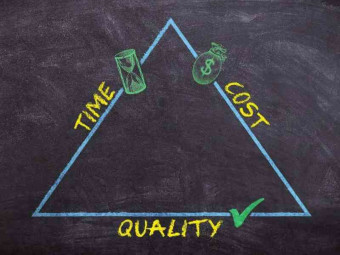Designthinking Stepbystep In55min
Tags: Design Thinking
Kick-start your Design Thinking journey with 12 activities to immediately put in practice with this pragmatic guide
Last updated 2022-01-10 | 3.8
- Enterprise Design Thinking- Design Thinking practices
- Observe
- Reflect & Make loop
What you'll learn
* Requirements
* NoneDescription
This DESIGN THINKING for agile product scoping course is designed for those who don't have time to loose and want to move quickly from theoretical concepts to practice.
This course is for you if :
You are interested by Agile product scoping,
You are interested by Design Thinking,
You want to be able to practice Design Thinking BEFORE you finish reading.
The activities covered are :
Stakeholder Mapping : the visual process of laying out all the stakeholders of a product, project, or idea on one map. The main benefit of a stakeholder map is to get a visual representation of all the people who can influence your project and how they are connected.
Hopes & Fears : Learn and discuss your stakeholders' hopes and fears before starting a project or on-boarding new team members.
Design Research Plan : a document that clarifies how to approach the research, touching upon research goals, selected methodologies, types of participants and tools used, timeline and locations.
Synthesize Research : Synthesis is the combining of information in a meaningful way, and it requires more than simply placing quotes from other sources into your paper. In order to successfully synthesize your research findings, you need to summarize the information, evaluate it, interpret it, and draw conclusions for your team.
Empathy Map : Build empathy for your users through a conversation informed by your team’s observations.
Scenario Map (AS-IS journey) : Build a better understanding of your users’ current experience by documenting collective understanding of user workflows and are best used as precursors to exploring new ideas or for finding the right problem to solve.
Big Ideas Vignettes : Rapidly diverge on a breadth of possible solutions to meet your users’ needs any time your team gets stuck or you feel there’s a better way to do something. Everyone has ideas. Don’t make the mistake of leaving idea generation only to the designers, the engineers, the project owners, or the executives. Everyone has a unique perspective on the user and the problem, so everyone should contribute ideas for solutions.
Prioritization Grid : Decide your next move by focusing on the intersection of importance and feasibility. While prioritization is most helpful at the beginning of a project, it’s also worth taking time to prioritize before an iteration or sprint. You can use this activity to prioritize anything, from ideas generated in big-idea vignettes to user stories in your backlog.
Scenario Map (TO-BE journey) : Draft a vision of your user’s future experience to show how your ideas address their current needs by envisioning a better future for your users. Use them as you’re coming up with potential solutions to see how your ideas would fit within your user’s world, and how they might address the their needs. A To-be Scenario Map is a great artifact to put in front of stakeholders and users to align on your team’s intent.
Storyboards : Communicate ideas through visual stories that showcase how they fit into your users’ lives once you know the problem you’re trying to solve and for whom. Note that storyboarding isn’t the same as wireframing. Instead, you use Storyboards to create a low-fidelity narrative that focuses on people and their actions, thoughts, goals, emotions, and relationships. While you can include user interfaces as props in your story, avoid drawing too many screens.
Cognitive Walkthrough & Feedback Grid : Gather and organize feedback from users, team members, or stakeholders anytime you’re trying to make sense of what people are trying to tell you. You can create them during—or directly after—a user observation, a Playback, or an engagement.
MVP & Experience-based Roadmap : Break down your long-term experience into the most essential near-term outcomes for your user once you’ve identified your user’s real problems, and established a direction on how to solve them. This will help you scope what you’d like your users to be able to do, and when you’ll deliver those experiences.
This course is based on Enterprise Design Thinking toolkit and is aiming to facilitate your learning journey.
Who this course is for:
- Agile Coach
- Scrum Master
- UX/UI Designer
- Business Analyst
- Manager
- Product Owner
Course content
4 sections • 13 lectures
Introduction Preview 02:29
With Enterprise Design Thinking, teams can work more efficiently, because they stay aligned and keep people at the center of their work.
It’s a proven way to come to better solutions, faster.
2 x faster to market
3 0 0 % return on investment
7 5 % increased team efficiency
Stakeholder Map Preview 03:46
Identify project stakeholders, their expectations, and their relationship to each other.
Hopes & Fears Preview 03:05
Learn and discuss each others’ hopes and fears before starting a project or on-boarding new team members.
Design Research Plan Preview 02:50
When your team needs a “reality check,” identify your assumptions and the best ways to address them.
Synthesize Research Preview 04:45
When you’re trying to solve a problem it can be tempting to slip into a technical discussion that focuses on features and functions. If you get caught up in the details too early, you risk inadvertently solving the wrong problem. Reframe your thinking by writing Needs Statements and answer the question: “What does our user actually need?”
Empathy Map Preview 02:57
Build empathy for your users through a conversation informed by your team’s observations.
On a large team, not everyone has the chance to talk to every user. Empathy Maps help synthesize your team’s collective knowledge about your users as a group, bringing you closer to a common understanding of who they are. You can use empathy mapping to refresh your team’s understanding before an important decision, or to quickly synthesize your data directly after an observation session. Empathy Mapping is best treated as an ongoing activity. As your understanding grows and evolves, revisit the activity periodically.
Scenario Map : AS-IS journey Preview 02:45
Build a better understanding of your users’ current experience.
As-is Scenario Maps help to document collective understanding of user workflows and are best used as precursors to exploring new ideas or for finding the right problem to solve.
Big Ideas Vignettes Preview 02:53
Rapidly diverge on a breadth of possible solutions to meet your users’ needs.
Any time your team gets stuck or you feel there’s a better way to do something. Everyone has ideas. Don’t make the mistake of leaving idea generation only to the designers, the engineers, the project owners, or the executives. Everyone has a unique perspective on the user and the problem, so everyone should contribute ideas for solutions.
Prioritization Grid Preview 03:20
Decide your next move by focusing on the intersection of importance and feasibility.
While prioritization is most helpful at the beginning of a project, it’s also worth taking time to prioritize before an iteration or sprint. You can use this activity to prioritize anything, from ideas generated in big-idea vignettes to user stories in your backlog.
Scenario Map : TO-BE journey Preview 03:12
Draft a vision of your user’s future experience to show how your ideas address their current needs.
To-be Scenario Maps can help you envision a better future for your users. Use them as you’re coming up with potential solutions to see how your ideas would fit within your user’s world, and how they might address the their needs. A To-be Scenario Map is a great artifact to put in front of stakeholders and users to align on your team’s intent.
Storyboards Preview 03:53
Communicate ideas through visual stories that showcase how they fit into your users’ lives.
You can use Storyboards once you know the problem you’re trying to solve and for whom. Note that storyboarding isn’t the same as wireframing. Instead, you use Storyboards to create a low-fidelity narrative that focuses on people and their actions, thoughts, goals, emotions, and relationships. While you can include user interfaces as props in your story, avoid drawing too many screens.
Cognitive Walkthrough & Feedback Grid Preview 06:49
Gather and organize feedback from users, team members, or stakeholders.
Use this anytime you’re trying to make sense of what people are trying to tell you. You can create them during—or directly after—a user observation, a Playback, or an engagement.
MVP & Experience-based Roadmap Preview 03:54
Break down your long-term experience into the most essential near-term outcomes for your user.
We recommend using this activity once you’ve identified your user’s real problems, and established a direction on how to solve them. This will help you scope what you’d like your users to be able to do, and when you’ll deliver those experiences.








 This course includes:
This course includes:






